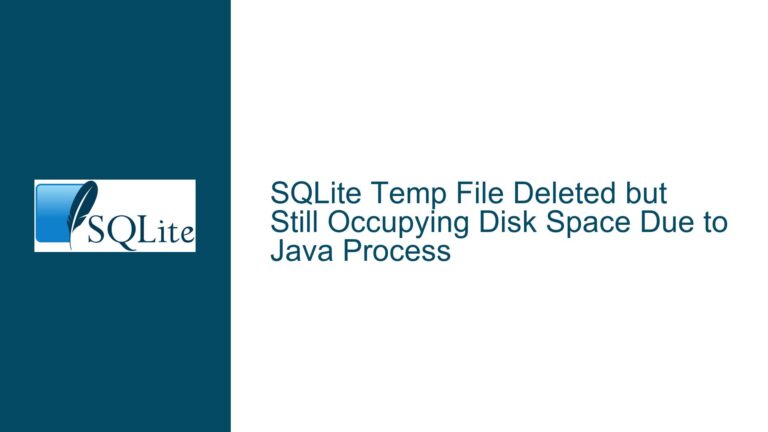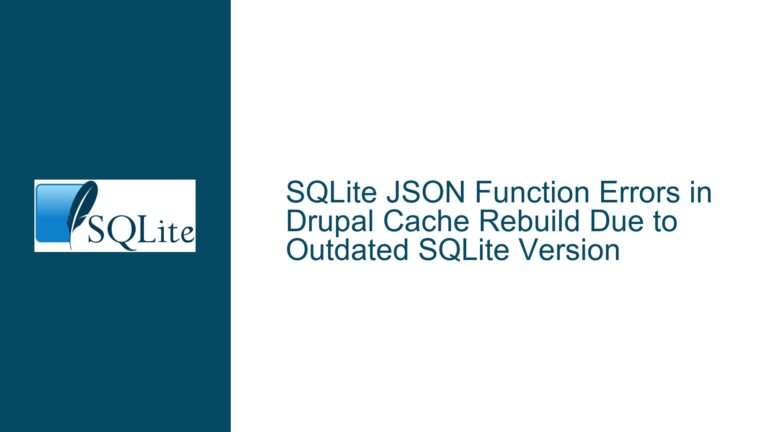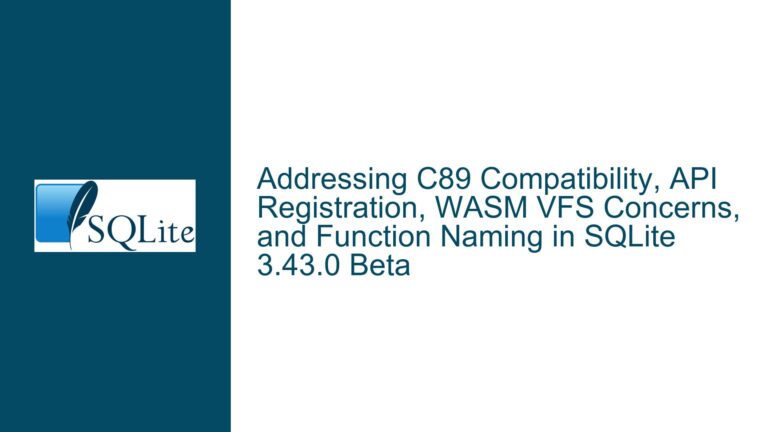Read-Only Connection Fails in WAL Mode Until First Write Operation
Understanding WAL Mode and Read-Only Connection Failures
Issue Overview
When an SQLite database transitions from the default rollback journal mode to Write-Ahead Logging (WAL) mode, the behavior of subsequent read-only connections changes significantly. In the scenario described, a user encountered an error when attempting to query a database through a read-only connection immediately after switching to WAL mode. The error manifests as:
[logging-persist] cannot open file at line 46870 of [bc8a7f24e4]
[logging-persist] os_unix.c:46870: (0) open(/Users/xxx/test/test.sqlite-wal) - Undefined error: 0
[logging-persist] unable to open database file in "select * from test_tbl limit 10"
This error occurs because the read-only connection cannot access or create the -wal file, which is mandatory for WAL mode operation. The problem resolves itself only after a write operation is performed on the database through a separate read-write connection.
Key Technical Nuances
WAL Mode Mechanics:
- In WAL mode, SQLite uses two auxiliary files:
<database>.wal(write-ahead log) and<database>.shm(shared memory). These files track uncommitted changes and coordinate access between multiple connections. - When a database is first opened in WAL mode, the
-waland-shmfiles are created only when the first operation (read or write) is executed. This is a critical detail often overlooked.
- In WAL mode, SQLite uses two auxiliary files:
Read-Only Connection Constraints:
- A connection opened with
SQLITE_OPEN_READONLYcannot modify the database or its auxiliary files. If the-walfile does not exist at the time the read-only connection is opened, SQLite cannot proceed, as the WAL mechanism requires this file to determine the database state.
- A connection opened with
Dependency on Write Operations:
- The initial creation of the
-waland-shmfiles is triggered by the first operation on the first read-write connection. If no operation is performed after enabling WAL mode, these files remain absent. A read-only connection opened afterward will fail because it cannot create the missing-walfile.
- The initial creation of the
Sequence of Events Leading to Failure
- Connection 1: Switches the journal mode to WAL but performs no further operations.
- Connection 2: Opens in read-only mode and attempts a query.
- At this point, the
-walfile does not exist because Connection 1 did not execute any operation to trigger its creation. - The read-only connection lacks permission to create the
-walfile, resulting in an error.
- At this point, the
- Post-Write Recovery:
- After a write operation (e.g.,
INSERT) via Connection 1, the-waland-shmfiles are created. - Subsequent read-only connections can now access the
-walfile and function correctly.
- After a write operation (e.g.,
Root Causes of Read-Only WAL Failures
1. Delayed Creation of WAL Files
The -wal and -shm files are not created when the journal mode is set to WAL. Instead, they are generated when the first database operation (read or write) occurs on a read-write connection. If no operation is performed after switching to WAL mode, these files remain absent.
2. Read-Only Permissions and File Creation
A read-only connection cannot create or modify the -wal or -shm files. If these files are missing, the connection cannot proceed, as WAL mode depends on their presence to manage transactions.
3. Misunderstanding of WAL Initialization
Developers often assume that setting the journal mode to WAL immediately initializes the necessary files. However, SQLite defers file creation until the first operation to optimize performance and avoid unnecessary file I/O.
4. Platform-Specific File Handling
On Unix-like systems (e.g., macOS, Linux), file permissions and directory write access can exacerbate this issue. For example, if the directory containing the database lacks execute permissions, even read-write connections might fail to create the -wal file, though this is a separate issue from the one described.
Resolving Read-Only WAL Errors and Best Practices
Step 1: Ensure WAL File Initialization
After enabling WAL mode, perform a no-op write or read operation on the read-write connection to force the creation of the -wal and -shm files.
Example Fix
-- After setting journal_mode = WAL, execute a dummy transaction
BEGIN IMMEDIATE;
COMMIT;
This triggers the creation of the -wal file without modifying the database.
Step 2: Validate File Permissions
Ensure the database directory allows the SQLite process to create and read files. On macOS/Linux:
ls -ld /Users/xxx/test
Verify that the directory has rwx permissions for the user running the application.
Step 3: Use PRAGMA journal_mode = WAL Correctly
Explicitly check the journal mode after setting it. Some drivers or ORMs may not propagate the mode change immediately.
Step 4: Handle Read-Only Connections Gracefully
If your application relies on read-only connections, ensure the -wal file exists before opening them. This can be done by:
- Performing a write operation first.
- Using a separate initialization step to create the WAL files.
Step 5: Consider Alternative Journal Modes
If read-only access is a primary use case and WAL initialization is impractical, consider using journal_mode = DELETE (the default). However, this sacrifices WAL’s benefits, such as improved concurrency.
Step 6: Monitor for Orphaned WAL Files
After a crash or improper shutdown, the -wal and -shm files may become orphaned. Use PRAGMA wal_checkpoint(TRUNCATE); to clean them up during maintenance periods.
Step 7: Adjust Connection Opening Logic
If read-only connections must open immediately after WAL mode is enabled, modify the application logic to ensure a write operation occurs first. For example:
# Python pseudocode
conn_rw = sqlite3.connect('test.sqlite')
conn_rw.execute('PRAGMA journal_mode = WAL;')
conn_rw.execute('CREATE TABLE IF NOT EXISTS init (dummy INTEGER);') # Force WAL creation
conn_ro = sqlite3.connect('test.sqlite', uri=True, flags=sqlite3.SQLITE_OPEN_READONLY)
Step 8: Understand SQLite’s Documentation
The SQLite WAL documentation explicitly states:
"A read-only WAL-mode database connection cannot automatically recover from a missing
-walfile. The read-only connection will fail with an error if the-walfile is missing."
This behavior is intentional and not a bug.
Step 9: Test with Different SQLite Versions
While the issue is consistent across versions, test with the latest SQLite build (3.45+ as of 2024) to ensure no regressions or improvements affect your use case.
Step 10: Implement Retry Logic
For applications where write operations are infrequent, implement retry logic in read-only connections:
import sqlite3
import time
def query_with_retry(db_path, query, max_retries=3):
for _ in range(max_retries):
try:
conn = sqlite3.connect(db_path, flags=sqlite3.SQLITE_OPEN_READONLY)
return conn.execute(query).fetchall()
except sqlite3.OperationalError as e:
if "unable to open database file" in str(e):
time.sleep(1) # Wait for WAL initialization
else:
raise
raise RuntimeError("Query failed after retries")
Final Recommendation
Always pair WAL mode initialization with an immediate write or read operation to ensure auxiliary files are created. For read-heavy applications, this one-time initialization is a small price to pay for WAL’s concurrency benefits.






